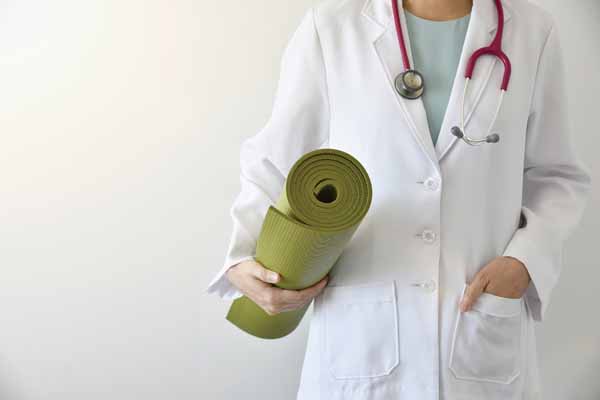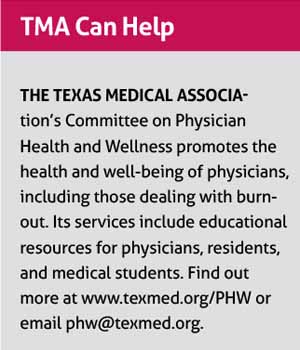
A new “think tank” group of six physicians led by Anil Nanda, MD, kept in mind two basic facts while looking at physician stress: First, burnout is common in the profession; second, a growing number of physicians now work for employers, not themselves.
Given that, physicians have to be proactive about creating a work atmosphere that gives them breathing room to rest, see their families, and not deal with patients or paperwork all the time, Dr. Nanda says. But the way to sell that sanity time to employers is by focusing on the organization’s bottom line, not on physician wellness.
“There are ways of approaching the corporate entities [to emphasize] wellness as an important issue, not just for physician [health] but also because it can save money in terms of fewer physicians retiring and improved morale,” said Dr. Nanda, a Lewisville specialist in allergy and immunology.
Dr. Nanda’s group was one of nine that brainstormed at the inaugural Physician Health and Wellness Exchange on March 2 in Houston. The event, organized by the Texas Medical Association and Baylor College of Medicine in Houston, brought together physicians, medical students, and other health care professionals and scientists to address burnout – a problem facing three out of four physicians nationwide, according to The Physicians Foundation 2018 Physician Survey (tma.tips/2018PFsurvey).
TMA has been a leader in promoting physician mental health for decades. Its latest initiative began in 2018 after TMA Executive Vice President and CEO Louis J. Goodman, PhD, called on TMA staff to expand outreach to physicians about the wellness tools and services TMA offers.
The exchange, part of Dr. Goodman’s initiative, was planned by TMA’s Committee on Physician Health and Wellness. It was designed in part to show physicians that help is available, says Toi B. Harris, MD, associate provost of institutional diversity, inclusion, and equity and student services at Baylor.
“Previously, the emphasis was on what the individual could do to address their concerns [regarding stress and burnout],” said Dr. Harris, a professor of psychiatry and a committee member who helped create the event and served as moderator. “More recently, researchers in the field have also examined institutional strategies to create the kind of environment where people can thrive while they learn and work.”
Seeking solutions
One of the exchange’s top goals: Showcase a series of wellness initiatives produced by participating medical schools.
“Dissemination is key,” Dr. Harris told Texas Medicine. “There are innovative programs in our region that few know about outside of our schools.”
A poster session highlighted medical schools’ original research on ways individuals and the organizations they work for can improve physician wellness. Each of the 25 posters was judged by academic faculty and members of TMA’s Physician Health and Wellness Committee.
One Baylor study tracked the impact of “sunshine grants” – small grants no bigger than $600 – that helped promote art, yoga, and improved collaboration among physicians. The researchers found that boosting wellness for medical school faculty and staff “may have an impact beyond the academic medical department.” Judges selected it as a winning poster among those submitted by faculty members.
The winning poster presented by residents focused on the impact of moderate exercise on stress. The study from the McGovern Medical School at UTHealth in Houston found that a five-month step challenge involving neurology residents, fellows, and faculty “was associated with improved emotional, physical, and social health.”
The winning poster submitted by medical students, also from McGovern Medical School, found social media outreach can create a stronger sense of community and equip medical students with tools to reduce stress.
Other research included:
- Baylor and Rice University in Houston found that for premedical students, “adaptive coping” methods, such as redirecting anger toward positive action or just taking a walk, are more closely associated with happiness than “non-adaptive” methods such as self-blame or substance use.
- A McGovern Medical School survey found that 94% of the school’s students believe participating in service work has a positive impact on their well-being, and 86% feel it has a positive impact on patient care.
- Working with MD Anderson Cancer Network, Harris Health System, and the U.S. Veterans Administration, Baylor found that increasing bedside time with patients helped residents feel “significantly” more connected with patients and less burned out.
Detachment from patients – as well as coworkers – helps fuel stress among physicians, says event keynote speaker Alan Swann, MD, a professor in psychiatry and behavioral sciences at Baylor.
“We work in a potentially highly cooperative environment,” Dr. Swann said. “And yet people are alienated and separated from their coworkers by conditions that many of us work under.” In part, that is because today’s “more complicated [health] system … intervenes and bureaucratizes health care,” he said.
The costs of burnout
Physician burnout has been linked to medical errors and lapses in professionalism, according to a 2018 study in the Journal of the American Medical Association (tma.tips/JAMAburnout). Additionally, the 2018 Physicians Foundation Survey found that 78% of U.S. physicians experience feelings of burnout at least some of the time, and 49% would not recommend medicine as a career to their children. (See “Battling Burnout,” April 2018 Texas Medicine, pages 10-13, www.texmed.org/BattlingBurnout.)
Prior to the exchange, a survey of think-tank participants pinpointed frustration with technology as one of the key stressors among health care professionals and students, along with working long hours and eating poorly.
Stress-related problems affect all physicians, but they seem to hit physicians in some specialties harder than others, Dr. Nanda told Texas Medicine. (See www.texmed.org/BurnoutBySpecialty.) Physicians also need to move away from the belief that they need to be superhuman about stress, he says.
“We don’t really like to talk about our own stresses,” Dr. Nanda said. “It’s nice to hear others talk about it, to know that you’re not alone.”
Seven medical schools participated in the conference: Baylor; McGovern Medical School; Texas A&M College of Medicine in Bryan; University of the Incarnate Word School of Osteopathic Medicine in San Antonio; The University of Texas Medical Branch School of Medicine in Galveston; UT Health San Antonio Long School of Medicine; and UT Southwestern Medical School in Dallas. Rice University also participated.

Tex Med. 2019;115(6):30-31
June 2019
Texas Medicine Contents Texas Medicine Main Page